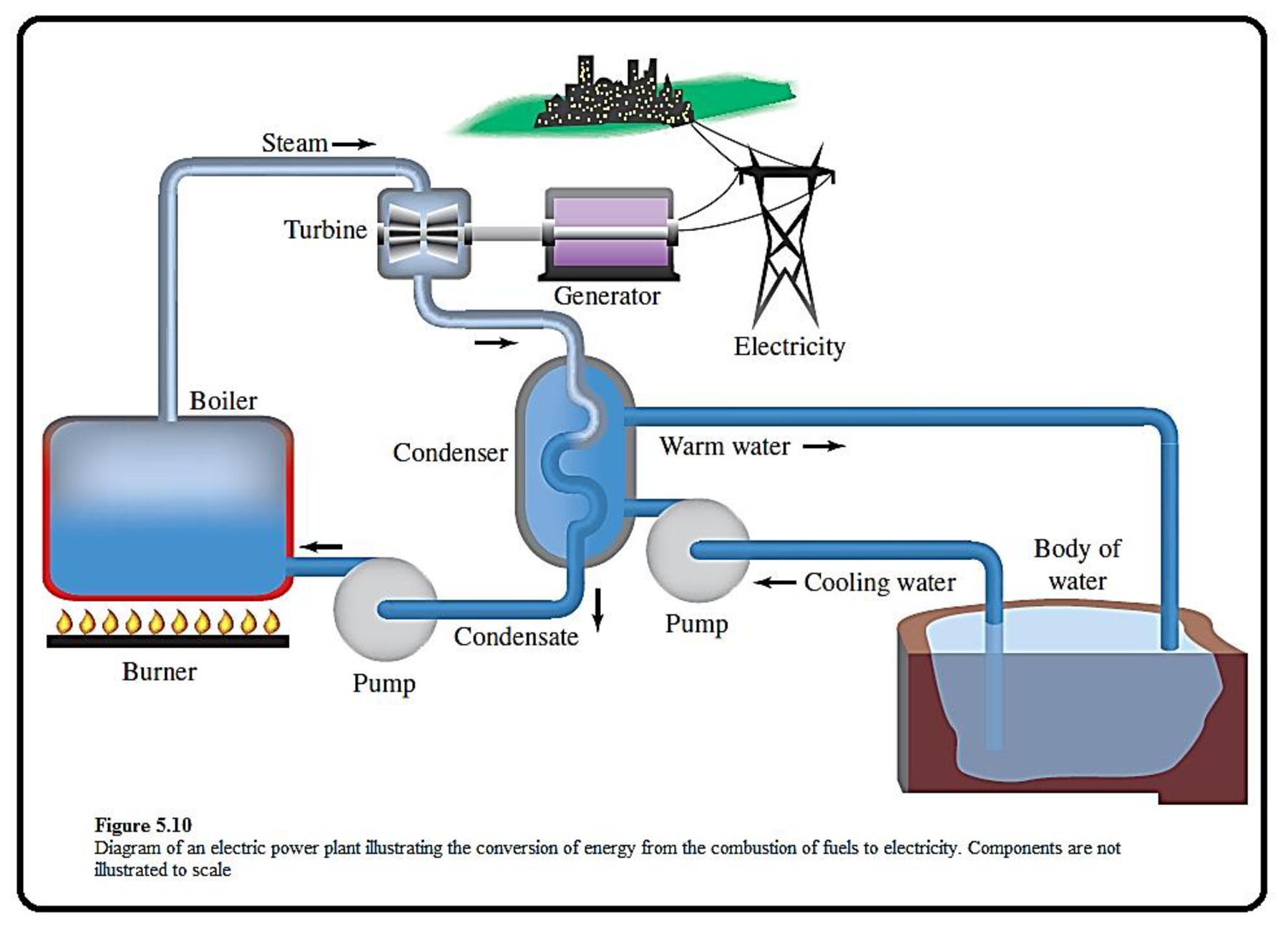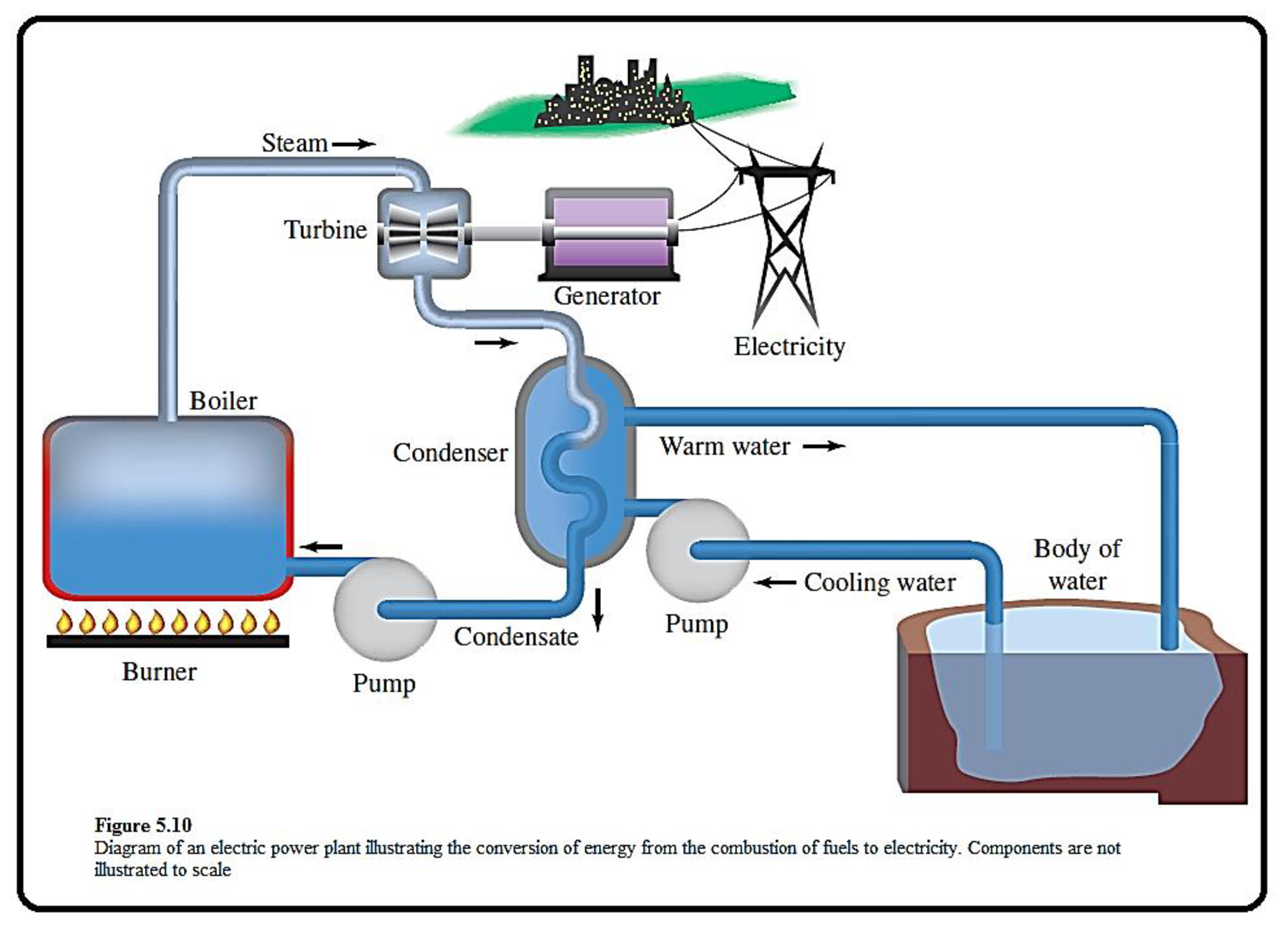
Concept explainers
Energy exists in different forms in our natural world. In Figure 5.10, identify where:
- a. Potential (stored) energy of the fuel is converted to heat.
- b. Kinetic energy of water molecules is converted to mechanical energy.
- c. Mechanical energy is converted to electrical energy.
- d. Electrical energy is converted into forms such as heat and light.
(a)
Interpretation:
Energy exists in different forms in our natural world. From the given figure of components of an electric power plant it has to be identified that where potential energy of the fuel is converted to heat.
Concept Introduction:
A fuel is a substance which releases energy in the form of heat while undergoing combustion. Hydrocarbons which have high heats of combustion make it a best fuel.
The general equation for the complete combustion of a hydrocarbon is written below,
_ CxHy + _ O2 → _ CO2 + _ H2O
Coal is a good fuel becouse it is completely made up of carbon atoms. It is a fossil fuel.
Coals can be classified and graded according to the carbon percent and the impurity percent such as sulfur.
There different types of energy forms in the world and some of these energy forms are mentioned below,
Mechanical energy: Energy produced by a machine or a moving part.
Thermal energy: Energy produced by heat.
Light energy: Energy produced from light.
Potential energy: Energy stored in an object due to its position above the earth’s surface.
Kinetic energy: Energy produced by motion of an object.
Explanation of Solution
The given figure which depicts the components of an electric power plant is shown below,

Figure 1
Coal is a best fuel to produce heat energy, the steam produced through this process is used to generate electricity.
Energy exists in different forms in our world.
In the given representation, the fuel in the burner is a source of potential energy. When it burned, some of its potential energy is converted to heat throgh combustion. This heat is converted into kinetic energy of steams.
(b)
Interpretation:
Energy exists in different forms in our natural world. From the given figure of components of an electric power plant it has to be identified that where kinetic energy of water molecule is converted to mechanical energy.
Concept Introduction:
A fuel is a substance which releases energy in the form of heat while undergoing combustion. Hydrocarbons which have high heats of combustion make it a best fuel.
The general equation for the complete combustion of a hydrocarbon is written below,
_ CxHy + _ O2 → _ CO2 + _ H2O
Coal is a good fuel becouse it is completely made up of carbon atoms. It is a fossil fuel.
Coals can be classified and graded according to the carbon percent and the impurity percent such as sulfur.
There different types of energy forms in the world and some of these energy forms are mentioned below,
Mechanical energy: Energy produced by a machine or a moving part.
Thermal energy: Energy produced by heat.
Light energy: Energy produced from light.
Potential energy: Energy stored in an object due to its position above the earth’s surface.
Kinetic energy: Energy produced by motion of an object.
Explanation of Solution
The given figure which depicts the components of an electric power plant is shown below,

Figure 1
Coal is a best fuel to produce heat energy, the steam produced through this process is used to generate electricity.
Energy exists in different forms in our world.
In the given representation, the fuel in the burner is a source of potential energy. When it burned, some of its potential energy is converted to heat throgh combustion. This heat is converted into kinetic energy of steams. By spinning the turbine, the kinetic energy of the steam is converted to mechanical energy.
(c)
Interpretation:
Energy exists in different forms in our world. From the given figure of components of an electric power plant it has to be identified that where mechanical energy is converted to electrical energy.
Concept Introduction:
A fuel is a substance which releases energy in the form of heat while undergoing combustion. Hydrocarbons which have high heats of combustion make it a best fuel.
The general equation for the complete combustion of a hydrocarbon is written below,
_ CxHy + _ O2 → _ CO2 + _ H2O
Coal is a good fuel becouse it is completely made up of carbon atoms. It is a fossil fuel.
Coals can be classified and graded according to the carbon percent and the impurity percent such as sulfur.
There different types of energy forms in the world and some of these energy forms are mentioned below,
Mechanical energy: Energy produced by a machine or a moving part.
Thermal energy: Energy produced by heat.
Light energy: Energy produced from light.
Potential energy: Energy stored in an object due to its position above the earth’s surface.
Kinetic energy: Energy produced by motion of an object.
Explanation of Solution
The given figure which depicts the components of an electric power plant is shown below,

Figure 1
Coal is a best fuel to produce heat energy, the steam produced through this process is used to generate electricity.
Energy exists in different forms in our world.
In the given representation, the fuel in the burner is a source of potential energy. When it burned, some of its potential energy is converted to heat throgh combustion. This heat is converted into kinetic energy of steams. By spinning the turbine, the kinetic energy of the steam is converted to mechanical energy. The mechanical energy generated from the spinning turbne is converted to electrical energy by rotating a wire in a magnetic field.
(d)
Interpretation:
Energy exists in different forms in our world. From the given figure of components of an electric power plant it has to be identified that where electrical energy is converted into forms such as heat and light.
Concept Introduction:
A fuel is a substance which releases energy in the form of heat while undergoing combustion. Hydrocarbons which have high heats of combustion make it a best fuel.
The general equation for the complete combustion of a hydrocarbon is written below,
_ CxHy + _ O2 → _ CO2 + _ H2O
Coal is a good fuel becouse it is completely made up of carbon atoms. It is a fossil fuel.
Coals can be classified and graded according to the carbon percent and the impurity percent such as sulfur.
There different types of energy forms in the world and some of these energy forms are mentioned below,
Mechanical energy: Energy produced by a machine or a moving part.
Thermal energy: Energy produced by heat.
Light energy: Energy produced from light.
Potential energy: Energy stored in an object due to its position above the earth’s surface.
Kinetic energy: Energy produced by motion of an object.
Explanation of Solution
The given figure which depicts the components of an electric power plant is shown below,

Figure 1
Coal is a best fuel to produce heat energy, the steam produced through this process is used to generate electricity.
Energy exists in different forms in our world.
In the given representation, the fuel in the burner is a source of potential energy. When it burned, some of its potential energy is converted to heat throgh combustion. This heat is converted into kinetic energy of steams. By spinning the turbine, the kinetic energy of the steam is converted to mechanical energy. The mechanical energy generated from the spinning turbne is converted to electrical energy by rotating a wire in a magnetic field. This electrical energy, carried to the city by the power lines, light bulbs and heats homes.
Want to see more full solutions like this?
Chapter 5 Solutions
Chemistry In Context
Additional Science Textbook Solutions
Organic Chemistry (8th Edition)
SEELEY'S ANATOMY+PHYSIOLOGY
Essentials of Human Anatomy & Physiology (12th Edition)
Human Physiology: An Integrated Approach (8th Edition)
General, Organic, and Biological Chemistry - 4th edition
Biochemistry: Concepts and Connections (2nd Edition)
- Which of the following molecules are NOT typical carbohydrates? For the molecules that are carbohydrates, label them as an aldose or ketose. HO Он ОН ОН Он ОН но ΤΗ HO ОН HO eve Он он ОН ОН ОН If polyethylene has an average molecular weight of 25,000 g/mol, how many repeat units are present?arrow_forwardDraw the a-anomer cyclized pyranose Haworth projection of the below hexose. Circle the anomeric carbons. Number the carbons on the Fischer and Haworth projections. Assign R and S for each chiral center. HO CHO -H HO -H H- -OH H -OH CH₂OH Draw the ẞ-anomer cyclized furanose Haworth projection for the below hexose. Circle the anomeric carbons. Number the carbons on the Fischer and Haworth projections. HO CHO -H H -OH HO -H H -OH CH₂OHarrow_forwardName the below disaccharide. Circle any hemiacetals. Identify the numbering of glycosidic linkage, and identify it as a or ẞ. OH HO HO OH HO HO HO OHarrow_forward
- What are the monomers used to make the following polymers? F. а. b. с. d. Вецер хочому なarrow_forward1. Propose a reasonable mechanism for the following transformation. I'm looking for curved mechanistic arrows and appropriate formal charges on intermediates. OMe MeO OMe Me2N NMe2 OTBS OH xylenes OMe 'OTBSarrow_forwardWhat is the polymer made from the following monomers? What type of polymerization is used for each? а. ОН H2N но b. ن -NH2 d. H₂N NH2 довarrow_forward
- Condensation polymers are produced when monomers containing two different functional groups link together with the loss of a small molecule such as H2O. The difunctional monomer H2N(CH2)6COOH forms a condensation polymer. Draw the carbon-skeleton structure of the dimer that forms from this monomer.arrow_forwardWhat is the structure of the monomer?arrow_forward→ BINDERIYA GANBO... BINDERIYA GANBO. AP Biology Notes Gamino acid chart - G... 36:22 司 10 ☐ Mark for Review Q 1 Hide 80 8 2 =HA O=A¯ = H₂O Acid HIO HBrO HCIO Question 10 of 35 ^ Σ DELL □ 3 % Λ & 6 7 * ∞ 8 do 5 $ 4 # m 3 ° ( 9 Highlights & Notes AXC Sign out Carrow_forward
- Which representation(s) show polymer structures that are likely to result in rigid, hard materials and those that are likely to result in flexible, stretchable, soft materials?arrow_forward3. Enter the molecular weight of the product obtained from the Williamson Ether Synthesis? OH OH & OH excess CH3l Ag₂Oarrow_forwardPlease answer 1, 2 and 3 on the endarrow_forward
 Chemistry: The Molecular ScienceChemistryISBN:9781285199047Author:John W. Moore, Conrad L. StanitskiPublisher:Cengage Learning
Chemistry: The Molecular ScienceChemistryISBN:9781285199047Author:John W. Moore, Conrad L. StanitskiPublisher:Cengage Learning Introductory Chemistry: A FoundationChemistryISBN:9781337399425Author:Steven S. Zumdahl, Donald J. DeCostePublisher:Cengage Learning
Introductory Chemistry: A FoundationChemistryISBN:9781337399425Author:Steven S. Zumdahl, Donald J. DeCostePublisher:Cengage Learning World of ChemistryChemistryISBN:9780618562763Author:Steven S. ZumdahlPublisher:Houghton Mifflin College Div
World of ChemistryChemistryISBN:9780618562763Author:Steven S. ZumdahlPublisher:Houghton Mifflin College Div- Chemistry: Matter and ChangeChemistryISBN:9780078746376Author:Dinah Zike, Laurel Dingrando, Nicholas Hainen, Cheryl WistromPublisher:Glencoe/McGraw-Hill School Pub Co
 Chemistry for Engineering StudentsChemistryISBN:9781337398909Author:Lawrence S. Brown, Tom HolmePublisher:Cengage Learning
Chemistry for Engineering StudentsChemistryISBN:9781337398909Author:Lawrence S. Brown, Tom HolmePublisher:Cengage Learning





